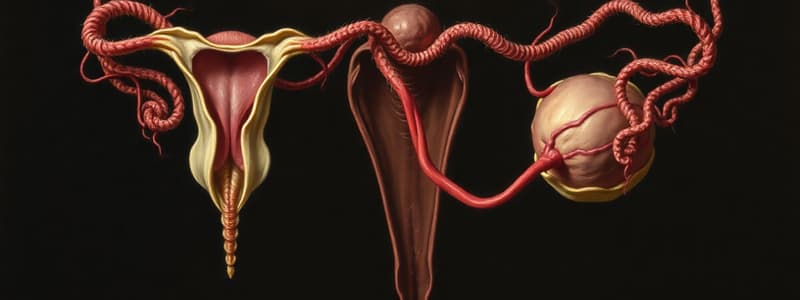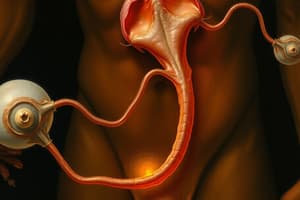Podcast
Questions and Answers
What is the primary function of testosterone in the male reproductive system?
What is the primary function of testosterone in the male reproductive system?
- Aids in sperm transportation
- Neutralizes vaginal acidity
- Provides energy for sperm motility
- Stimulates spermatogenesis and regulates libido (correct)
What is the primary function of Follicle-Stimulating Hormone (FSH) in the male reproductive system?
What is the primary function of Follicle-Stimulating Hormone (FSH) in the male reproductive system?
- Enhances prostate fluid secretion
- Stimulates Leydig cells for testosterone production
- Inhibits sperm production
- Stimulates Sertoli cells to support spermatogenesis (correct)
Which component of seminal fluid is responsible for energizing sperm motility?
Which component of seminal fluid is responsible for energizing sperm motility?
- Proteins from epididymal secretions
- Fructose in seminal vesicle secretions (correct)
- Citrate in prostatic fluid
- Prostatic fluid
Which component contributes the most to semen volume?
Which component contributes the most to semen volume?
Which hormone stimulates the production of testosterone by Leydig cells?
Which hormone stimulates the production of testosterone by Leydig cells?
What is the function of inhibin produced by Sertoli cells?
What is the function of inhibin produced by Sertoli cells?
What is the primary role of sperm produced in the seminiferous tubules?
What is the primary role of sperm produced in the seminiferous tubules?
Which gland produces alkaline fluid rich in fructose that aids in sperm motility?
Which gland produces alkaline fluid rich in fructose that aids in sperm motility?
Which of the following pH levels represents prostatic fluid?
Which of the following pH levels represents prostatic fluid?
Where does spermatogenesis primarily take place within the male reproductive system?
Where does spermatogenesis primarily take place within the male reproductive system?
Flashcards
Follicle-Stimulating Hormone (FSH)
Follicle-Stimulating Hormone (FSH)
A hormone produced by the anterior pituitary gland that stimulates Sertoli cells to help sperm production.
Sertoli cells
Sertoli cells
Cells in the testes that support sperm development and are stimulated by FSH.
Inhibin
Inhibin
A hormone made by Sertoli cells; it regulates FSH secretion, controlling sperm production.
Seminal Vesicle Fluid
Seminal Vesicle Fluid
Signup and view all the flashcards
Prostatic Fluid Composition
Prostatic Fluid Composition
Signup and view all the flashcards
Sperm's Role
Sperm's Role
Signup and view all the flashcards
Semen's Purpose
Semen's Purpose
Signup and view all the flashcards
Testosterone's Function
Testosterone's Function
Signup and view all the flashcards
Seminal Vesicle Secretion
Seminal Vesicle Secretion
Signup and view all the flashcards
Prostatic Fluid's Role
Prostatic Fluid's Role
Signup and view all the flashcards
Study Notes
Male Reproductive System
- Post Lab Activity 22 covers the male reproductive system.
Hypophyseal Control
- GnRH from the hypothalamus stimulates the anterior pituitary.
- The anterior pituitary releases LH and FSH.
- LH stimulates Leydig cells to produce testosterone.
- FSH stimulates Sertoli cells to facilitate spermatogenesis.
- Inhibin from Sertoli cells inhibits FSH secretion.
Spermatogenesis
- Detailed process of sperm production (illustrated with diagrams)
- Spermatogonia, primary spermatocytes, secondary spermatocytes, spermatids, and spermatozoa are part of the stages.
- Various cellular components (e.g., acrosomal vesicle, mitochondria) involved in the process are labeled.
- Specific locations in the seminiferous tubules are shown.
Substances/Secretions
- Sperm: Male gametes produced in seminiferous tubules. Carry paternal genetic material to fertilize the female egg.
- Semen: Viscous fluid comprising sperm and secretions from accessory glands (seminal vesicles, prostate gland, bulbourethral glands). Provides a medium for sperm transport, nourishment, and protection.
- Testosterone: Primary male sex hormone produced by Leydig cells in the testes. Stimulates spermatogenesis, regulates libido, and promotes secondary sexual characteristics (e.g., muscle growth, voice deepening).
- Seminal Vesicle Secretions: Alkaline fluid rich in fructose, prostaglandins, and clotting factors supporting sperm motility, uterine contractions to aid transport, and semen coagulation after ejaculation.
- Prostatic Fluid: Slightly acidic fluid containing citrate, zinc, polyamines, and enzymes (e.g., PSA). Neutralizes vaginal acidity, liquefies coagulated semen, and supports sperm motility and survival.
- Bulbourethral Gland Secretions: Clear, mucus-like fluid released before ejaculation. Lubricates the urethra for smooth sperm passage and neutralizes residual acidity from urine.
- Epididymal Secretions: Glycoproteins (e.g., CRISP1, Immobilin), enzymes, and small molecules (e.g., carnitine). Promotes sperm maturation, motility, and storage. Protect sperm by coating them with stabilizing proteins. Maintain sperm immobility to conserve energy for ejaculation.
- Immobilin: High-molecular-weight glycoprotein in epididymal fluid that keeps sperm immobile during storage and helps conserve energy for maturation.
- Mucus: Secreted by various glands in the reproductive tract. Provides lubrication, and protects and supports sperm mobility.
Hormones
- Luteinizing Hormone (LH): Secretion of the anterior pituitary that stimulates Leydig cells for testosterone production.
- Follicle-Stimulating Hormone (FSH): Secretion of the anterior pituitary that stimulates Sertoli cells for spermatogenesis.
- Inhibin: Secreted by Sertoli cells that inhibits FSH secretion, aiding in spermatogenesis regulation.
Summary of Key Substances/Secretions
- Sperm: Has neutral pH (~7). Contains genetic material, enzymes, and mitochondria. Low contribution (~1-5%) to total semen.
- Seminal Vesicle Fluid: Slightly alkaline pH (~7.2-7.6). Contains fructose, prostaglandins, and clotting proteins. High percentage contribution (~60-70%) to total semen.
- Prostatic Fluid: Slightly acidic pH (~6.5). Contains citrate, zinc, enzymes (e.g., PSA), and polyamines. Moderate contribution (~25-30%) to total semen.
Pathologic Conditions
- Benign Prostatic Hyperplasia (BPH): Non-cancerous prostate enlargement, common in older men. Symptoms include difficulty urinating, nocturia (frequent nighttime urination), weak urine stream, and incomplete bladder emptying.
- Testicular Cancer: Rare malignancy affecting testes in young men (15-35 years). Symptoms include lump/swelling in the testicle, dull ache in the groin, and general discomfort in the scrotum. Treatment involves surgery, chemotherapy, or radiation, depending on the cancer's stage and type. Usually has a high rate of survival with early detection.
- Erectile Dysfunction (ED): Inability to achieve or maintain an erection. Physical causes include diabetes, hypertension, atherosclerosis; Psychological causes include stress, anxiety and depression. Lifestyle factors such as smoking and lack of exercise can also contribute. Possible treatments include medication like phosphodiesterase inhibitors (e.g., sildenafil) and counseling.
- Prostatitis: Inflammation of the prostate gland. Symptoms may include pain during urination, pelvic pain, frequent urination, and flu-like symptoms (in acute cases). Common causes include bacterial infection (E. coli), trauma, or autoimmune reactions. Treatment options often include antibiotics for bacterial cases and anti-inflammatory drugs or alpha-blockers for chronic cases.
- Varicocele: Enlarged veins in the scrotum (pampiniform plexus). Symptoms may include aching scrotal pain, visible/palpable veins, and potential infertility. Treated with surgery (varicocelectomy) or minimally invasive embolization.
- Hydrocele: Fluid accumulation around the testicle causing scrotal swelling. Symptoms are usually painless. Causes include congenital defect or secondary to injury/infection. Often treated with observation in infants; surgical drainage or hydrocelectomy for more symptomatic cases.
- Prostate Cancer: Malignancy of the prostate gland (commonly slow-growing) with potential for metastasis in later stages. Symptoms include difficulty urinating, blood in urine/semen, and pelvic/back pain. Risk factors often involve older age, family history, African descent, high-fat diet, and sedentary lifestyle. Diagnosis typically involves PSA blood tests, a digital rectal exam, and biopsies. Treatment strategies include active surveillance, surgery, radiation therapy, hormone therapy, or chemotherapy.
Studying That Suits You
Use AI to generate personalized quizzes and flashcards to suit your learning preferences.
Related Documents
Description
This quiz assesses your knowledge of the male reproductive system as outlined in Post Lab Activity 22. It covers topics such as hypophyseal control of reproductive hormones, the process of spermatogenesis, and the substances involved in male gamete production. Test your understanding of the structures and functions essential for male reproduction.




